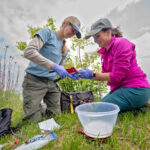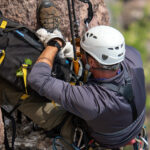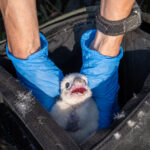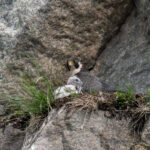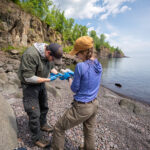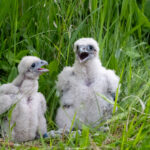North Shore Highlights
June along Minnesota’s North Shore means long days, crashing waves, and—for a dedicated crew of climbers, biologists, photographers, and volunteers—the rush of peregrine falcon banding season. This year’s effort took me to 15 nesting sites scattered along the rugged cliffs of Lake Superior, each one a window into the lives of these extraordinary raptors.
Four Days, Fifteen Sites, and a Few Surprises
Between June 10 and June 25, the teams completed four full days of banding, spaced out over three weeks to accommodate weather, logistics, and the birds themselves. Every site tells its own story, and 2025 was no exception.
Two territories that had chicks the week before our arrival turned up empty—a reminder that life on the cliffs can be harsh, and survival is never guaranteed. At another site, the parent falcons were actively defending their territory, diving and calling as we approached, yet no matter how carefully the climbers searched, the eyrie (nest) couldn’t be located. And at a fourth site, adults were no longer present and no nest or chicks were found.
At the other 11 sites, the number of chicks per nest ranged from a solo youngster to a lively brood of four. In total, 29 chicks were banded this season along the North Shore.
The Team Behind the Work
The North Shore banding season is coordinated by Jackie Fallon, Vice President of Field Operations and Minnesota State Coordinator for the Midwest Peregrine Society. With more than three decades of experience managing Minnesota’s peregrine territories, Jackie is the driving force behind the conservation work here. She organizes the schedules, assembles the crews, secures the necessary permits, and ensures that every banding follows state and federal guidelines.
By law, only wildlife management agency personnel—such as the U.S. Fish and Wildlife Service and state wildlife agencies—or those they specifically authorize are allowed to visit peregrine nests. Banding itself can only be performed by individuals who are licensed to do so. All others, including climbers, assistants, data recorders, and photographers, take part as volunteers helping Jackie carry out this mission.
A typical banding crew runs like a small, specialized expedition. The climbing team usually includes two skilled climbers plus one or two support staff. These are the people who rappel down sheer cliffs to reach the eyrie, often while the parent falcons circle overhead, calling and diving in defense of their young.
Photographers play a key role in the team as well. They document the entire process—from the climbers’ descent and the nest site itself to the banding and health checks—providing both a scientific record and a visual story of the day’s work. Clear photographs of adult leg bands are especially valuable. The large, multi-colored bands placed on the left leg can be read through binoculars or a spotting scope from as far as 700 feet away, making photos a powerful tool for confirming whether familiar falcons have returned to the same territory or if new birds have taken over.
Every role in the crew is essential, but it’s Jackie’s leadership, experience, and dedication that tie it all together—ensuring the work is done safely, efficiently, and to the highest scientific standards.
How Banding is done
The best time to band peregrine chicks is between 17 and 22 days old. At this age, the young falcons are nearly adult-sized but their flight feathers are not fully grown. That makes it possible to fit the correct bands without risk of the chicks flying off. Beyond this age range, chicks may jump prematurely, attempting to escape—and a fall from a cliff or building at this stage could be fatal.
Collecting the chicks is one of the most challenging parts of the job. Peregrines are highly protective parents—vocal and persistent in defending their young. As climbers approach the nest, the adults swoop and call in an effort to drive them away. Occasionally, they may pass very close. Birds that have had prior encounters with people sometimes respond with greater intensity. In all cases, peregrines work to deter intruders, rarely making physical contact but more often relying on repeated dives and loud vocalizations.
Once the climbers safely retrieve the chicks, they are carried to a nearby spot, often a grassy or shaded area. There is no formal banding station; everything needed fits into a backpack. Jackie, or another licensed bander she designates, places two bands on each chick: a lightweight aluminum federal band on the right leg and a multi-colored band with large letters and numbers on the left for easier field identification.
An assistant holds each chick securely, keeping it calm while the bander works quickly. The scribe records every detail: the site name, bander’s name, band numbers, age, sex, weight, crop size (a sign of how recently the bird has eaten), and any notes on overall health of the chick. Banders also perform a complete health check, including an examination of eyes, ears, and mouth for signs of parasites or fungal infections.
Peregrine falcon chicks can be accurately sexed at this age based on their size considering females are roughly 30% larger than males.
The chicks are always returned to the nest as quickly as possible. At first, the whole family is unsettled, but before long the adults and chicks calm down.
Why It Matters
Peregrine falcon banding isn’t just about the thrill of working with these incredible birds—it’s about science, conservation, and tracking the long-term health of the species. The information gathered on the North Shore each summer adds to decades of data, helping biologists monitor the health of the species, understand territory stability, survival rates, and movement patterns.
This year’s 29 banded chicks are part of that ongoing story. In the years ahead, we may spot them migrating along the lakeshore, setting up their own territories, or raising chicks of their own—proof that the cliffs of Lake Superior remain a stronghold for one of the world’s fastest animals.
2025 North Shore Peregrine Banding – By the Numbers
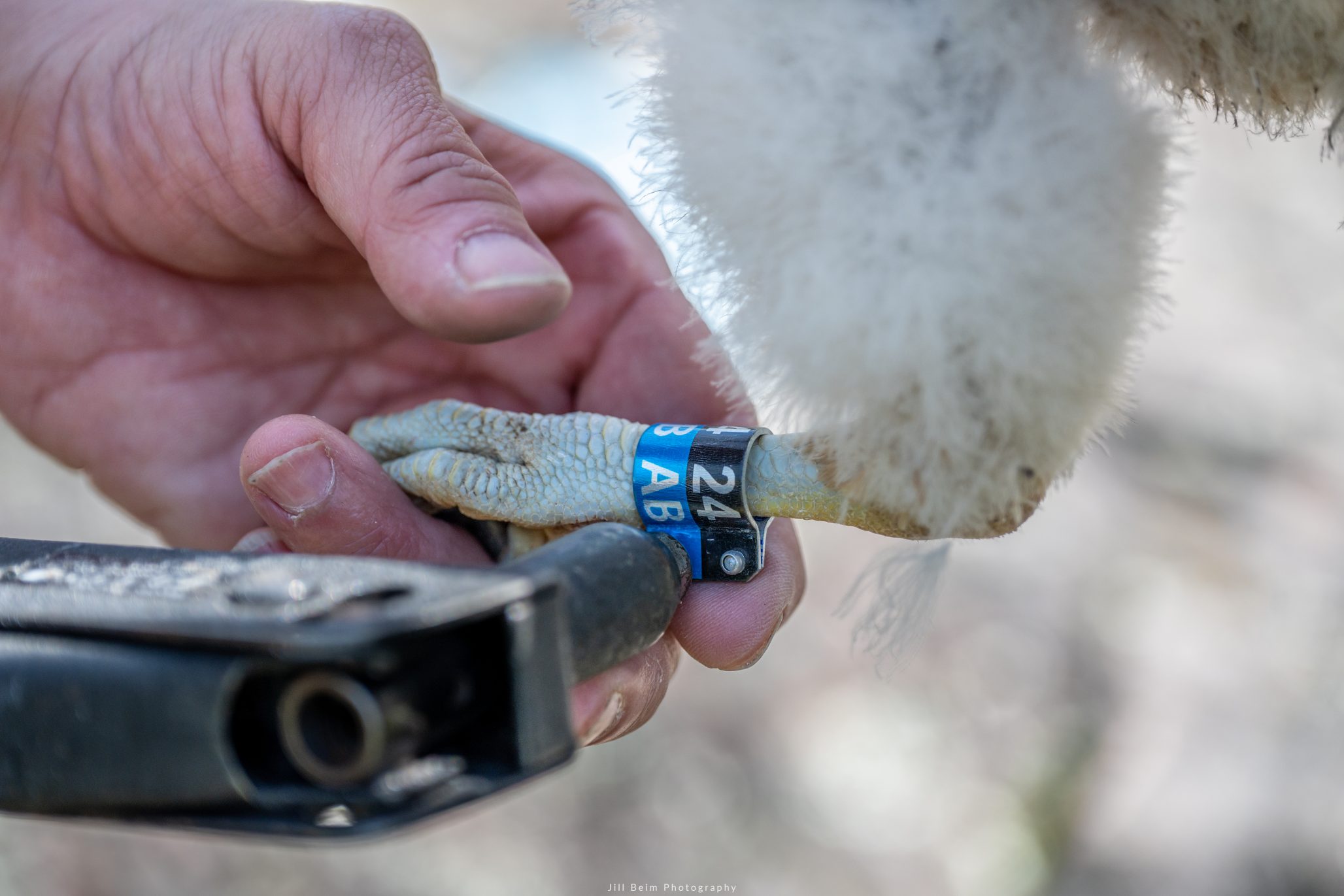
15 nest sites visited *
4 banding days
3 weeks (June 10 – June 25)
2 nests empty despite chicks the week before
1 eyrie unfound despite active adults
1 eyrie unfound and no adults present. Adults had been present weeks before.
1–4 chicks per nest
29 chicks banded in total
* This blog post references the 15 nest sites this photographer visited during the banding season. There are additional sites that are not represented by these stats.
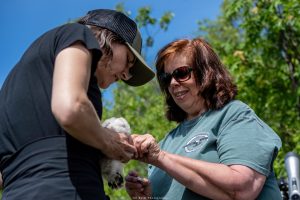
Meet Jackie Fallon
Vice President of Field Operations and Minnesota State Coordinator for the Midwest Peregrine Society, Jackie Fallon has spent over 36 years working with peregrine falcons. She manages nesting territories across Minnesota, advises other state coordinators in the region, and conducts banding according to strict federal and state guidelines.
Jackie is also a passionate educator, sharing the peregrine’s story with communities across the state. Whether banding chicks atop a cliff or teaching in a classroom, her goal is the same: protect these remarkable birds for generations to come.
Explore the Peregrine Banding Galleries
These 11 galleries showcase detailed photo stories from multiple nesting sites, capturing the dedication of the banding crews, the rugged cliffside eyries, adult falcons in flight, and the growth of the chicks. Each image is accompanied by informative captions, giving you a closer look at the fascinating process of banding and monitoring these remarkable birds of prey.
Explore 11 galleries of banding peregrine falcons, capturing cliffside eyries, chicks, banding crews, and adult falcons. Detailed captions reveal the full story behind each photograph.
